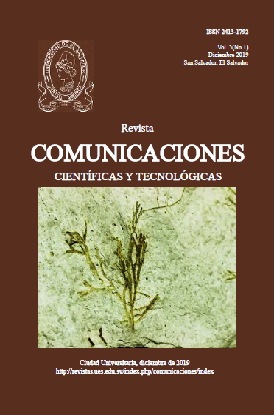Método de análisis destinado a la detección de Toxinas Marinas en productos pesqueros en El Salvador
Keywords:
Red Tides, Microalgae, Saxitoxins, Molluscs, Ligand Receptor AssayAbstract
Since 2011, researchers at the Laboratory of Marine Toxins (LABTOX-UES) have implemented the AOAC official method 2011.27 receptor binding assay (RBA) to quantify the analytical concentration of paralytic-type toxins (PSP) in bivalve molluscs, this has allowed to provide timely response to toxic outbreaks of Red Tides and other effects in El Salvador. In addition, the method was adapted to analyze saxitoxins in crabs, snails, sea turtles, and other marine organisms contaminated with potent poisons associated with microalgae that can be transferred to humans through the food chain. The application of this method has allowed to establish an early warning about the presence of PSP toxins during toxic outbreaks of Red Tides in 2011, 2012, 2013, 2014 and 2017. LABTOX-UES has provided technical information to officials of state institutions strengthening their decisions to establish closures for the extraction, commercialization and consumption of mollusks, mitigating the impact on public health and most likely safeguarding human lives. Other institutions such as the Marine Environment Laboratory in Monaco of the International Atomic Energy Agency (IAEA) and the National Oceanic and Atmospheric Administration (NOAA-USA), have been guarantors in the application of this methodology when comparing results. El Salvador is the first country in Latin America to apply this test in microplate format.
Downloads
References
Barraza, J. 2009. Toxicon 54: 895-896.
Amaya, O. et al 2012. Harmful Alge News, 45
Powell C et al 1999. Natural Toxins 7: 393 400.
Van Dolah F. et al 2009. Journal of AOAC International 92: 1705-1713.
Amaya, O. et al 2014. Harmful Alge News 48
Downloads
Published
How to Cite
Issue
Section
License
Copyright (c) 2021 Oscar Amaya, Gerardo Ruiz, Rebeca Quintanilla

This work is licensed under a Creative Commons Attribution-NonCommercial 4.0 International License.






